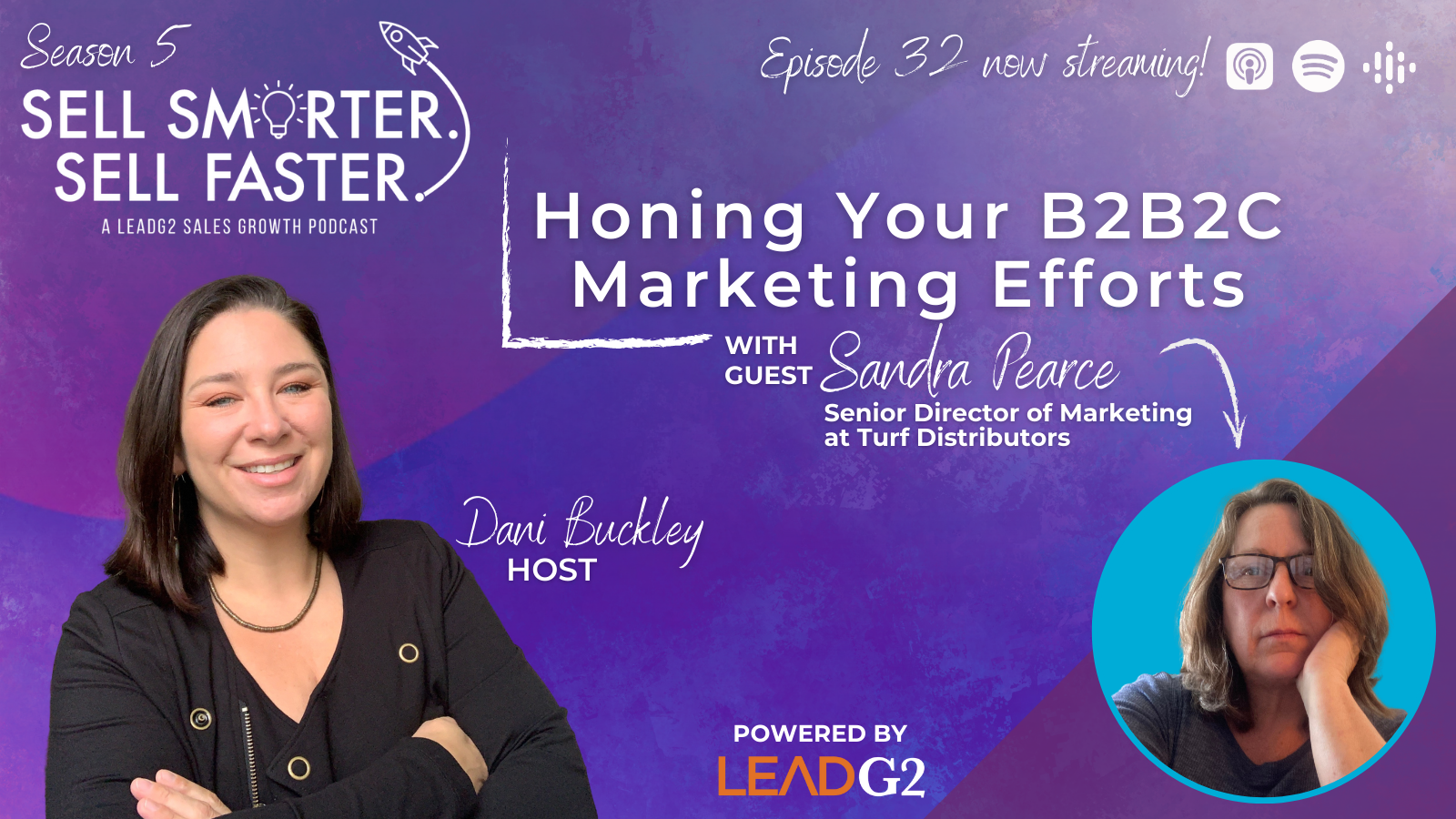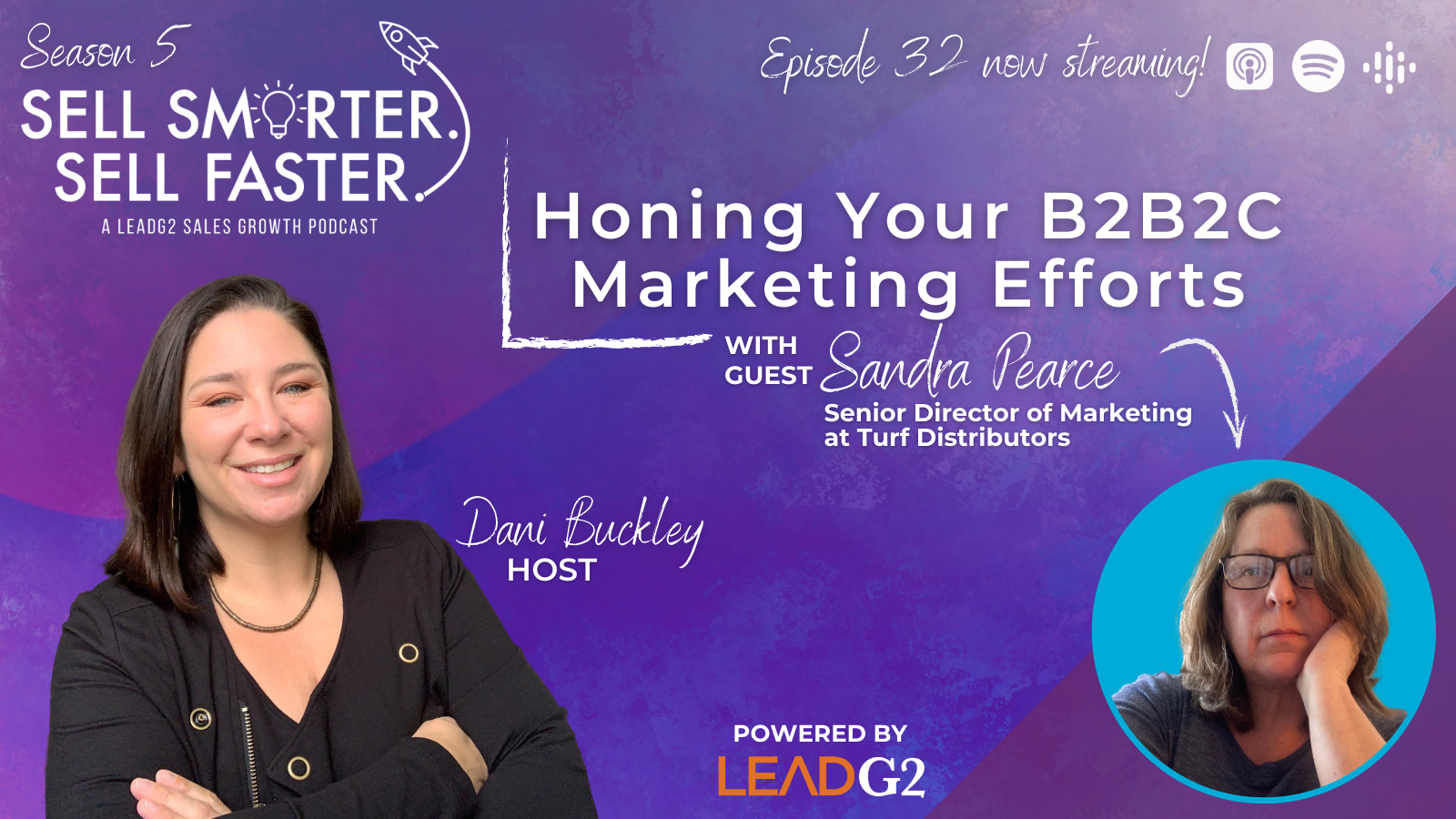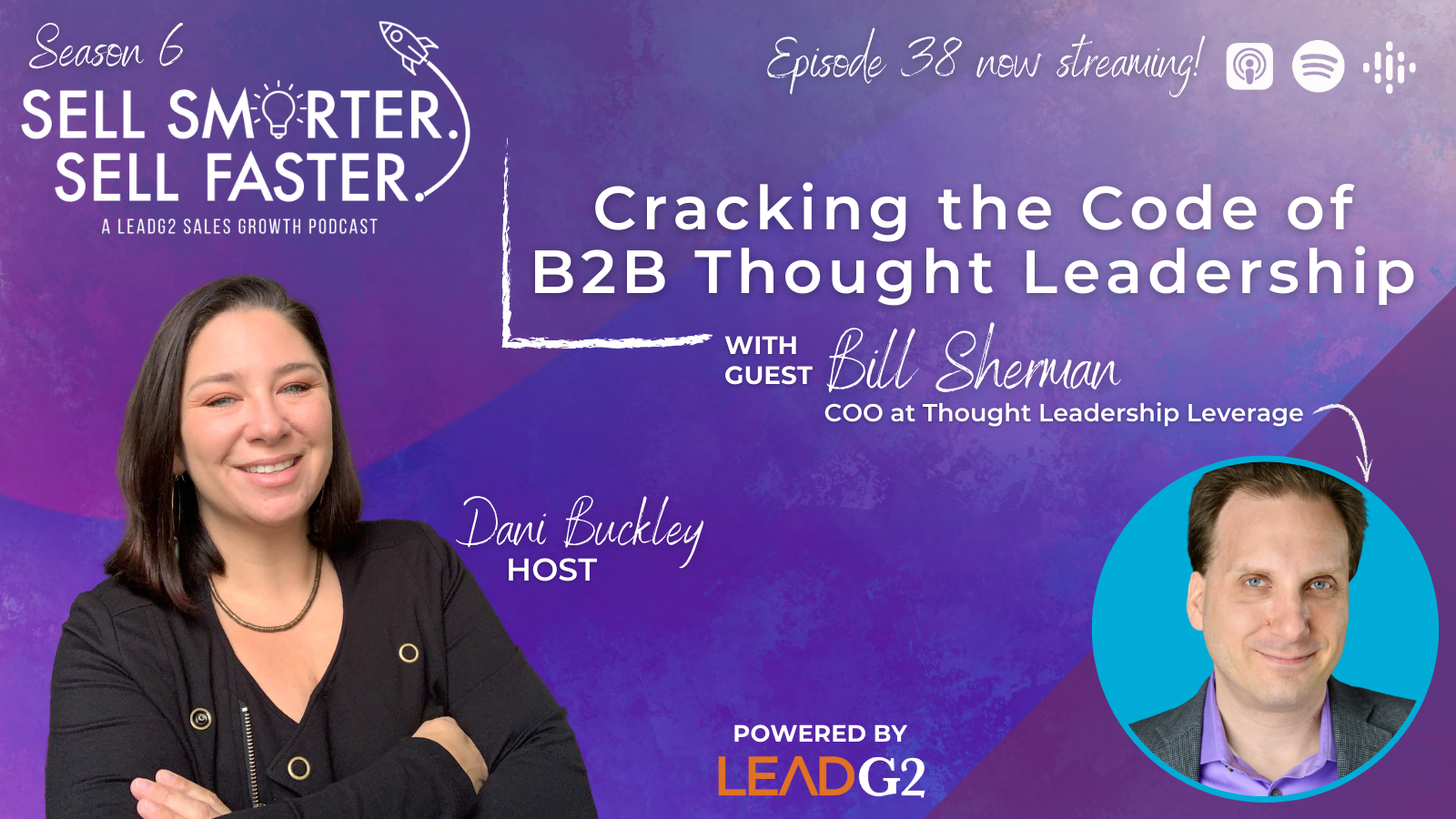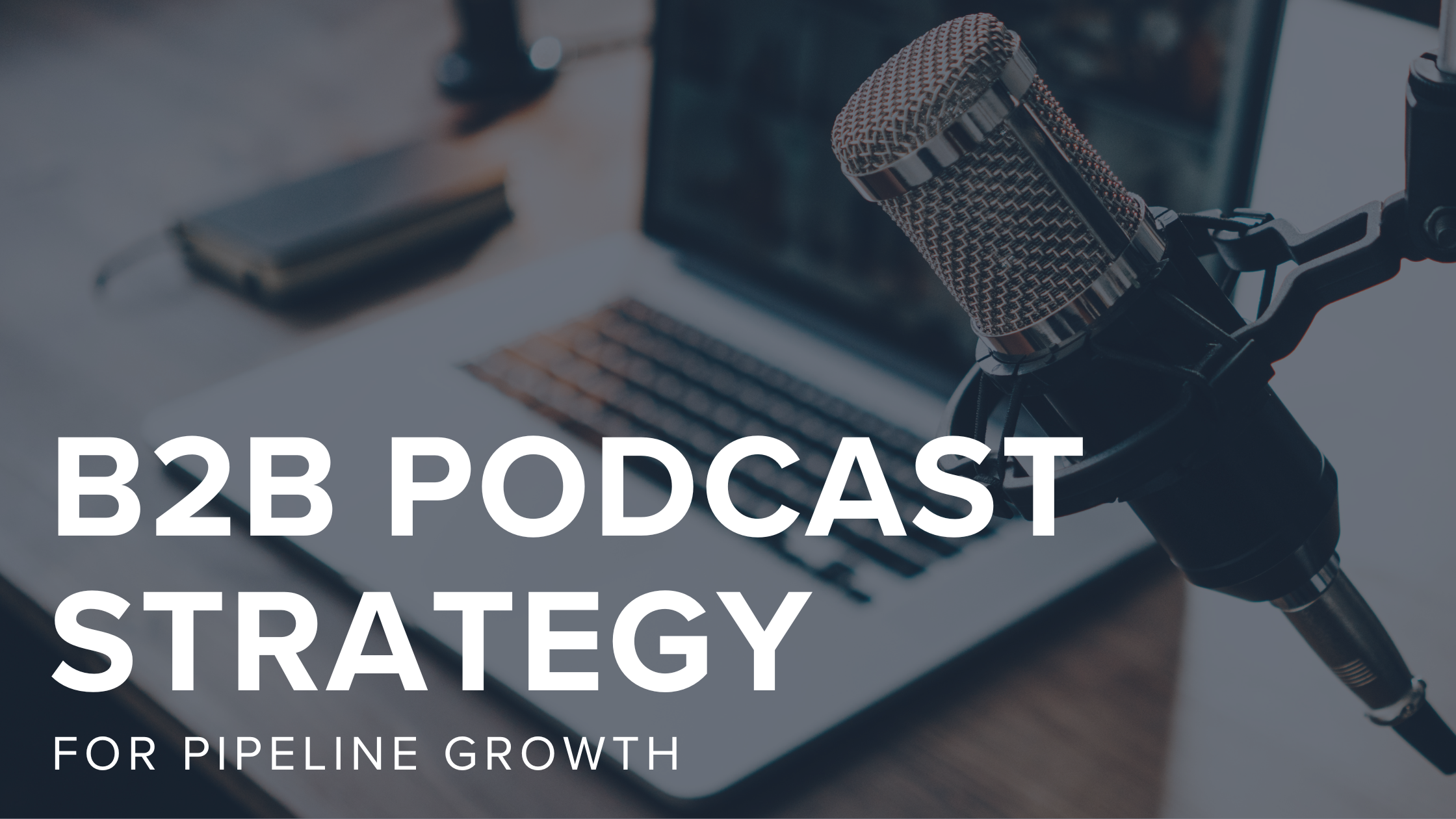Cracking the Code of B2B Thought Leadership with Bill Sherman
In this episode, we're breaking down how thought leadership can play an important role in maximizing your B2B sales efforts. Here we tackle...


In this episode, we’re diving into the world of B2B2C, discussing how to attract both businesses and consumers to your solutions while maintaining your core message and identity as an organization.
We ask questions like: how do you define B2B2C exactly? What are some of the top challenges to expect when implementing a B2B2C marketing strategy? And what are some effective approaches for building strong partnerships with other businesses in a B2B2C marketing environment?
Joining Dani to tackle those questions and more is the great Sandy Pearce, Senior Director of Marketing at Turf Distributors.
Sandy makes so many amazing points, like:
How one of the biggest challenges in B2B2C marketing is not spreading your teams too thin
Why it pays to have the tightest and most well integrated tech stacks
And how the minute you start to make assumptions about who you are selling to is the minute that you start falling down a rabbit hole

“I like to always do a good level set for everybody listening,” Dani says, kicking off the conversation. “Just to make sure we're all on the same page, what is B2B2C? What is your definition? Can you give some examples that you have?”
Sandra says. “The bottom line is this: if you sell products and you have someone else who sells them to an end user, you're actually in B2B2C, right? You have the opportunity to influence the sale from start to finish. You just don't have access to that end user yourself.”
“Well said. Very clear,” Dani says. “So, what makes the marketing for a B2B2C organization unique? What makes it different from straight B2B or B2C?
“You have to influence everyone, and sometimes you have to do it from a distance,” Sandra says. “You must not only convince your resellers to buy a product from you and sell them through, you also have to train them on your product, educate them, provide them with resources, teach them what to say and what not to say, how to differentiate you.
“It's like all those things that you went through to get that distribution customer to begin with, you have to do again to get that distribution customer to represent your brand properly as well as the way you want it to be represented online or in-person in a retail environment.
“So, it creates a lot of challenges,and it creates potential for a whole lot of work after the sale.”
Dani says, “Let's talk about challenges. What are the challenges that you that you specifically face at Turf Distributors?”
“You know, I think the challenge is always going to be spreading yourself too thin,” Sandra says. “If you're selling to resellers, you have a finite budget. That finite budget depends on what you have to do to get those sales.
“Marketing is a percentage of sales here. We treat marketing as a revenue source. We're not like a lot of companies where marketing does branding and it makes things look nice, and you do the sales material. We actually connect the revenue generated by marketing efforts to the true ROI of the company. We're just as entwined in that as sales.
“Our budget is very specifically set to achieve certain goals. Once you get to that point and you've sold that through to the reseller, your budget to help them take that over the finish line to the consumer is even smaller.
“So, the big challenge is to manage your resources, not spread your teams too thin.
“And we happen to do that by repurposing the materials that we've already created, repurposing the branded pieces, and offering those to our entire distribution channel to reuse themselves, right?
“We've already done the work, we've already laid the groundwork. We've got the brand voice, the look, the feel, all of the typical standard stuff. And if you tweak that slightly and turn that into a B2C piece and then just hand it on to your channel, they can just continue the same conversation that got them to buy from you to begin with, and now they get to sell it through to the end consumer.
“And if we can influence that in any way without jeopardizing our workflow for the heavy lifting, which is getting those resellers to begin with, and we can improve the lead to sale close ratio for our distributors, we now have even deeper engagement with our entire distribution channel because we're offering them tools that they don't have to create themselves.
“We become their go-to partner. So, it has a lot of rewards, it has a lot of risk, and it's a lot of work.”
“That makes sense,” Dani says. The tracking of ROI, right, being able to tie back revenue to your efforts is important. It's something you guys do. It's more challenging in B2B 2C, right? Is that a fair assumption to make?
“Well, of course it is, Dani. Why do you think, when I started with Turf Distributors, I hired LeadG2 and brought on HubSpot for all of our companies? Cause we're not just one company, right?
“We have five different business units that we have to support and serve and move products for in very complex channels. There's no way that any company has the budget to hire experts in every single field that we need expertise in. And that's where agencies like yours come into play. Cause you offer something in a very cost-effective way that gives us enterprise class knowledge and experience that we could never afford to hire for completely ourselves.
“So, thank you for that. You make my job easier.”
Dani chimes in, “Listeners, I did not set Sandy up to say that. But it's true, whether it's us or someone else, internally even, those challenges have to be addressed with the right expertise. Someone who has the capabilities, the experience, the bandwidth, the technology, all of that.”
“Yeah,” Sandy says. And let's be honest about this, right? So, one of the biggest challenges, of course, is resources and time. And how do you actually have enough of any of that? You have to have the right tech stack with the right partners doing the right things to move your sales funnel forward.
“Let's be perfectly clear, I've worked with Dani for a long time. I was with her at my last role. I've done this the hard way, which is without an agency and without HubSpot. And I've done this the easy way, which was with an agency in HubSpot. I'm not going back to the old way because it's just not sustainable, right?
“The trick is always to have as tight of a tech stack as you possibly can. So you have less technology to manage, have the best people working with you, and then empower your team to do their job with a double focus B2B and B2C, and do the tracking with the right key performance indicators to absolutely make sure that every effort that you are putting energy and time into is resulting in a positive ROI.
“This takes us right into our next question,” Dani says. “What does work? We're touching on some of the big stuff, right? Like having the right technology, having the right people in place to do this. Even you mentioned before, the ability to repurpose a tool or resources and things like that. Can you share a couple of really specific strategies or tactics that you've seen work?”
“So, the one thing that everybody in a B2B2C business needs to focus on is that sales and marketing are not separate,” Sandra says.
“You don't have a sales team, you don't have a marketing team. You have one team working together with different people fulfilling different roles. Because if sales does not own their lane, if we don't own what we do and the outcomes of it and deliver those leads to sales, we're not doing our job.
“But let's say we deliver those leads to sales, but now sales has a super low lead to close ratio. Why is that? Are we providing poor lead quality or have we just not set them up for success by teeing them up for the kind of leads we're handing to them?
“If we don't know what happens from right here to right there, when the money actually comes in, we don't know anything. All we're doing is doing our best to generate numbers.
“That's like saying, you know, ‘how many views did you get on your website?’ I really don't care. How many people came to my website and became a lead that I could nurture. I care.
“I think that that's the biggest thing for me. We have regular meetings with our sales leadership at each one of the business units...hashing out: what are our goals? What are we going to do? What do we have to accomplish? What tools do you need? Where do we want to push us? Where do you want us to push you?
“You do that, and then you meet constantly, consistently. You review the analytics and every single month you're responsible for owning your lane and what you deliver to them.
“And now they're responsible to you to answer back, ‘what did you do with what I handed you?’
“When you do that, it's a very symbiotic relationship. Teams become one, and now there's an open channel of communication, and it's no longer ‘marketing this’ and ‘sales that.’ It's ‘us,’ ‘we,’ ‘our.’ And the bottom line improves.
“And the key performance indicators are really simple for me. How many leads did I get you? How many leads got closed? And how much money did we generate from all of those efforts? Was it profitable? And if it was, let's just keep doing it again and do it again and do it again.
“Test and analyze and make sure that what you are doing is profitable early on in small steps. And then amplify your efforts. Do not just go in saying, ‘I know what I’ve got to do and I know what sales is going to do.’ And don't assume that all your parts and pieces are gonna run smoothly. Assume that something is going to break down.
“Start your campaigns, start your processes, test them, analyze them. Soon as those are smooth, then throw some more money at 'em.
“And then you have calculations, right? So, if I spend this much, I get that much and tie it all together in one platform with one tech stack that's all interconnected, where everybody can look at the same dashboards and look at the same data and information.
“It’s cause and effect and collaboration. And that's, that's what really results in profitable market effort marketing efforts.”
“That’s great,” Dani says. “In B2B2C in particular, you have a lot of different audiences, right? There's a lot of different resellers, there's a lot of different consumers, so it's easy to spread yourself and your messaging kind of thin and what I've seen you do well is be very targeted.
And I think that's a good tactic and and approach that people should remember is, you know, yes, you can repurpose content and you should repurpose things when you can. But also it needs to be personalized and the, and the messaging, the, the approach, the tactics you're using need to be unique to this specific audience, right?”
“Exactly,” Sandra say. “You lined it up right there. If I think about every single type of customer that we have to influence, that’s a long list , right?
So let's start at master distributors. I mean, I've got four different kinds of distribution partners or partner types, if you will. I've got direct to consumer, I have big box e-commerce, I have small mom and pop, and I have affiliate.
“If you can imagine the type of customer that exists out there in something like artificial turf and how that has to pass through the channels, including contractors and installers and construction companies, the list is just beyond huge. But it's not insurmountable.
“You're not having to tell the same story in 50 different ways. All you have to do is get a handle on your voice. What is your story?
“What is your value proposition? What's your differentiation? What makes you unique and sets you apart? And let that voice resonate through everything and change your content based on the audience slightly without losing the soul of who you are.
“And a lot of companies wind up trying to create something completely new and different for each persona. And that sometimes has the effect of diluting the brand value as opposed to amplifying the brand value.
“I think that's a fine line to walk. But if you know how you're going to connect the dots before you start telling the story, the story can tell itself for everybody.
“Of course, you have to use something like a marketing automation platform that can help you personalize and customize and A/B test and track to make sure that you're not being assumptive. The minute you start making assumptions in marketing is the minute you're going to go down a rabbit hole, wondering why your ROI is in the toilet.
Dani says, “For a more sophisticated organization like you guys, and many of the people listening, I think it's an unrealistic goal that you're only going to have one tool for everything. So, what's important is that you're building a tech stack that is very integrated. Would you agree?”
“I think that building a tech stack that is completely integrated is the only way to go, right?” Sandra says.
“So, it's easy when you're a smaller company and you're getting bigger. You stick with the CRM platform that you had before and add to it. You add to it to do this and do that, and you add a piece and don’t plan it out.
“What winds up happening is now that you're a pretty good sized company and you're generating a lot of money, but the minute you look under the hood, you see all of this duct tape holding everything together and when one piece of duct tape tears and the whole thing falls apart. Then you spend all your time on tech people trying to sort out your mess.
“I was given the opportunity here to look at what existed and look at what the perfect scenario would be, right? All of these companies, multiple ones using different CRM and sales enablement platforms, and we're moving to one primary group of tech stack, right? We're going to use Salesforce, we're going to use NetSuite, we're going to use HubSpot, and we're going to plug in from there. The primaries are there, sales enablement, CRM and marketing automation. Now what do we do now? What isn't existing there?
“We do a lot with the phone. We do a lot of inbound calls. Our marketing methodologies require people to call us and we push for them to call us. We need to be able to manage that. So, we've brought on a new system that basically digs into the public database or the phone records and lets us identify who's calling us. And we tie that into HubSpot. We tie that into our other platforms.
“We do the same thing with lead assignment to our salespeople. You get over five, six salespeople in an organization and managing lead distribution becomes overwhelmingly ‘weighty’ on sales leadership. That has to plug in to be seamless.
“I would say, if you're going to do this, figure out the primary pieces of technology you need. Make sure they all work together. Once, they all work together and they're handling the lion’s share, what has to happen now? Plug in other pieces that already have APIs, don't go out and build it. Don't go out and just do a little web book. Get software that works.
“There's enough selection out there that you can basically do anything you want to do with direct APIs that already exist so you aren't spending all of your time and your budget supporting tech staff to keep your systems together and working.”
“Mic drop,” Dani says. “Love it.”
So, let's talk about what might come up for folks when they are developing a B2B2C marketing strategy,” Dani says. “Are there certain misconceptions or pitfalls or obstacles that folks should avoid? Or common mistakes that you see?”
“I think the biggest mistake is not knowing your sales team's challenges,” Sandra says. “If you're in marketing and you're building this and you don't know the challenges of your sales team, you are going to hit some brick walls that you won't be able to get around easily.
“If you're on the sales side and you're building a B2B2C and you don't know what the marketing challenges are going to be, it's the same thing.
And no matter what, if you go back to the foundational issues of organizations in sales and marketing structure, you're going to find it was a lack of communication and understanding of each other's pain points and superpowers.
“So, you don't know what sales thinks you can do until you ask them, and then you realize they think that you can do anything and nothing all at the same time. And the same is reversed for marketing of sales. It's like, ‘why aren't you doing this? And why aren't you doing that?’ Well, because that doesn't work for us.
Again, I'm going to go back to that point from before, if you know the dots you want to connect, it's easy to connect the dots. If you think you know, and you haven't bothered to ask and map it out, you are going to find yourself going off in directions you never anticipated or planned for. And that's when things fall apart and don't. That's when it costs you money instead of making you money.
“So, to close us out,” Dani says. “Do you have any like final advice or anything that you haven't touched on that you want to be sure you pass along to those that are thinking about this stuff?”
“I think the one thing that I want to pass on is if you are B2B and you think you cannot influence your end customer because there's a reseller between you and them, you're wrong.
“If you think that you shouldn't be influencing that end customer because there is reseller between you and them, you're wrong.
“If you align your tools, your assets, your people, your processes with one goal in mind: helping your resellers get that sale done. At the end of the day, if that's your only focus, you're going to succeed.”

In this episode, we're breaking down how thought leadership can play an important role in maximizing your B2B sales efforts. Here we tackle...

1 min read
B2B podcasting strategy isn’t just about brand awareness—it’s about revenue. In today’s attention-starved digital environment, B2B buyers crave...